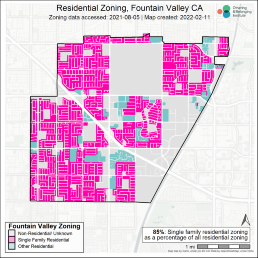Berkeley Study: 78 Percent of LA Region Residential Land Zoned for Exclusionary Housing
Single-family housing dominates residential zoning in six-county LA region, producing unequal health, educational and income outcomes, and creating opportunity barriers for low-income, Black and Latino residents.
BERKELEY: More than three-quarters (77.7 percent) of residential land in the housing-starved greater Los Angeles region is reserved for single-family homes, a new analysis by UC Berkeley's Othering & Belonging Institute (OBI) finds, creating a barrier to low-income people from accessing high-opportunity neighborhoods.
According to the study, the average amount of total land (including commercial areas and parks) exclusively reserved for single-family housing in the region is 40.67 percent. In contrast, only 11.8 percent of total land is available for denser, multi-family developments.
The investigation released Wednesday of 191 cities in six counties (Imperial, Los Angeles, Orange, Riverside, San Bernardino, and Ventura) also found that as the proportion of a neighborhood's single-family-only zoning increased, so did its white and Asian populations, while the Latino population significantly decreased.
The region's percentage of Black residents also declines as the percentage of single-family-only zoned areas increases.
The findings are consistent with a 2020 study of the San Francisco Bay Area produced by the same research team, which found that 85 percent of residential land in the San Francisco Bay Area was exclusively reserved for single-family-only housing and that communities with more restrictive zoning were whiter and wealthier.
"This study is damning evidence that low-density zoning in the Los Angeles region powerfully excludes people on the basis of race and class, said Stephen Menendian, the study's co-author and assistant director of OBI. "And, as we can see from the longitudinal data, is the principal mechanism for hoarding resources in ways that shape life outcomes."
Among the findings in the study, titled, "Single-Family Zoning in Greater Los Angeles," the researchers discovered that home prices are more than twice as high in neighborhoods that are at least 90 percent single-family-only zoned (median value of $811,492) compared to those that are less than 10 percent single-family-only zoned ($405,875).
It also found better educational outcomes in terms of math proficiency, high school graduation rates, and college degrees in more exclusionary communities, as well as better environmental health conditions, such as air quality and exposure to lead.
There is also a clear positive correlation between a child's neighborhood zoning and how much money they earn as an adult. Specifically, children born into families with incomes at the 75th percentile who grew up in communities with nearly 100 percent single-family zoning ended up making more than $10,000 per year as adults than children born into families at the same income level but living in communities with 25 percent or less single-family zoning.
The researchers also calculated the probability that children from different racial groups would make it to the top 20 percent of the income distribution as adults based on the degree of restrictive zoning in their community.
The results were unsettling for Black children in particular, who have the lowest rate of upward economic mobility among all children. It found that Black children had less than a 10 percent chance of making it to the top income quintile as adults except when raised in jurisdictions with near 100 percent single-family-only zoning.
The study emerges less than two years after OBI published a similar analysis of exclusionary zoning in the San Francisco Bay Area which led some cities, including Berkeley, to adopt resolutions that would loosen zoning laws.
It also comes in the midst of a national conversation on the role of zoning in perpetuating structural racism. OBI has since continued its investigation into zoning, and last year began tracking zoning reform efforts taking place across the country.
"We're also not claiming that zoning reform alone will solve the problems of unequal life outcomes associated with racial and class segregation or affordable housing," said Samir Gambhir, report co-author and OBI program manager. "But it is unlikely we can ever make substantial progress in these areas without first rethinking exclusionary zoning."

This study is unique in that it relied on original, laboriously constructed local zoning maps (191 in all) rather than using survey data or other imprecise shortcuts to calculate zoning. As a result, the study is accompanied by a repository of searchable zoning maps for every city in the region.
The maps offer a stark visualization of the overwhelming prevalence of single-family zoning, with nearly all the maps blotted in pink representing exclusionary jurisdictions with only patches of blue representing multi-family or other types of residential zones.
To address the harmful consequences of anti-density zoning for residents of the region, the report singles out 13 cities it identified as most in need of reform based on several factors, including the percentage of single-family zoning, affordable housing production, proximity to job centers, and community resources.
The cities identified as most in need of reform, according to the analysis, include Bradbury, La Habra Heights, Rolling Hills, Villa Park, La Canada Flintridge, Walnut, Moorpark, Chino Hills, Diamond Bar, Rolling Hills Estates, La Mirada, Glendora, and Cerritos.
"These are far from the only cities that have work to do to open up their communities to affordable and multi-family housing, but they can at least provide a starting point," said Chih-Wei Hsu, co-author of the report.
